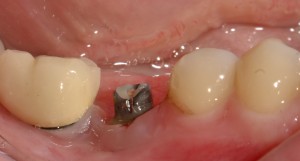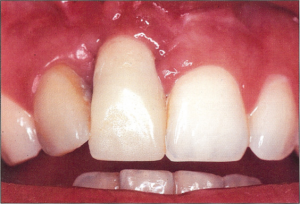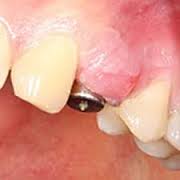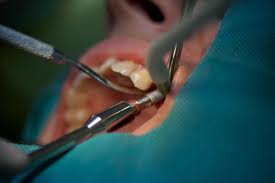Tooth implant removal

In some cases, you may need to tooth implant removal.
Clinical statistics of failed operations is in the range of 5-10%. Rejection of the implanted structure is quite rare and occurs for various reasons.
The rejection rate is not more than 1–2%. As a rule, rejection of the implant is observed within six months after its implantation.
In case of rejection of the implant, it is required to carry out its mandatory removal. If the structure is sufficiently movable, then it can be removed like a loose tooth.
When a part of the implant is engrafted to the jawbone, tooth implant is removed under local anesthesia. The hole in the bone tissue heals, as after tooth extraction.
Reasons to remove
- Lack of implant engraftment. If in the period from three to six months there is no osseointegration of the implant, then it must be removed. The procedure is quite simple. After a couple of months, it is possible to implant a new design. The probability of engraftment of a reinstalled implant will be equal to 99%. In case of repeated implantation, there is a 100% probability of its free installation.
- Overload of the structure or the presence of an inflammatory process (reimplantitis, perimucositis). The inflammatory process can occur both immediately after the implant is implanted, and after its engraftment. It can occur both due to a medical error, and as a result of non-compliance with the doctor's prescriptions in the postoperative period.
- The presence of structural problems of the implant, its incorrect position.
- The expired life of the installed implant may also be one of the reasons when removal is required.
Reasons for rejection of implants

- Transition of chronic diseases into acute form.
- Failure to follow the doctor’s recommendations after implantation.
- Inadequate oral hygiene, both before and after surgery.
- Incomplete preparatory phase before the operation.
- Low professional level and insufficient doctor experience.
- Decreased immunity.
- Jaw injury.
Medical errors that may cause implant rejection:
- The use of faulty equipment and low-quality tools. For example, the use of blunt cutters and the lack of cooling. As a result of overheating of the bone, necrosis of bone tissue cells passes and the implant is surrounded by fibrous tissue.
- In case of improper positioning of the implant.
- Violation of the requirements of asepsis and antiseptics.
- Lack of agreement between related specialists, as well as improper planning of the operation.
- In the absence of complete information about the patient’s health status, contraindications to the operation may not be fully taken into account.
- The implant is of poor quality.
- Wrong tactics of implantological treatment.
Symptoms of rejection

- The presence of severe pain in the area of the installed implant, which is not relieved by painkillers.
- Gingival hyperemia, edema.
- The presence of purulent discharge from the gums, at the site of implant placement.
- Bleeding gums.
- Bleeding immediately after surgery that cannot be stopped.
How to remove
Dental implant removal is a surgical operation that consists of several stages. Structural removal is performed under local anesthesia.
The operation is performed, as it were, in the reverse order:

- Removing the crown.
- Extraction from the jaw of an implant.
After surgery, the doctor must eliminate the cause of the violation of the osseointegration of the implant by appropriate treatment.
In the postoperative period, the patient must strictly carry out the treatment prescribed by the doctor and provide proper oral care.
Clinical case
- The patient had an implant in the area of a malignant neoplasm after irradiation. The patient was silent about the presence of this pathology and the treatment, and the surgeon did not pay due attention to changes in bone tissue in the area of the upcoming surgery to install the implant. Naturally, after irradiation, osseointegration of the implant did not occur due to a decrease in reparative processes in the bone tissue. After six months and the recommendations of the oncologists, the problem was solved: reimplantation and subsequent prosthetics were performed.
- The patient underwent orthodontic treatment. Space was required for implantation. Shortly before the end of treatment, bone grafting was performed, followed by implantation. The braces were not removed, as a result, the movement of the teeth continued. As a result, there was a compression of the titanium rod with neighboring teeth, and he could not take root. After some time, the patient was removed braces and reinstalled the implant.
When to remove
If there is an inflammatory process, it is urgent to get the help of a surgeon. If after two to three weeks the inflammatory process is not eliminated, removal of the implant will be required.
With the decision made to remove the implant, it is necessary to remove it as soon as possible. If this is not done, the jaw bone area will be destroyed and repeated engraftment will be impossible without bone grafting.
In the case of indications for removal of an implant that has taken root, more serious consequences may occur. The installation of a new implant will require reconstructive bone plastic surgery. The rehabilitation period in this case will be measured in years.
If possible, the implant should not be removed if there is no inflammation of the surrounding tissues.
How to avoid implant removal
- Dental implants and their consequences relate to a commercial service and are not included in the list of “Compulsory medical insurance” services in the Russian Federation.
- In this regard, free replacement of implants should be performed only in the clinic where the patient received this service.
- Even if there is a “lifetime guarantee” of the manufacturer for the implant, if it falls out, the manufacturer will recommend contacting the implantologist who performed the operation.
- Treatment of complications associated with implantation should also be carried out by a specialist of the clinic where the structures were installed.
- The cost of treating complications in another clinic can be two to three times higher than installing implants.
In connection with the foregoing, the choice of clinic and implantologist must be approached with great responsibility. It is necessary to discuss in advance all possible “ifs” with him.